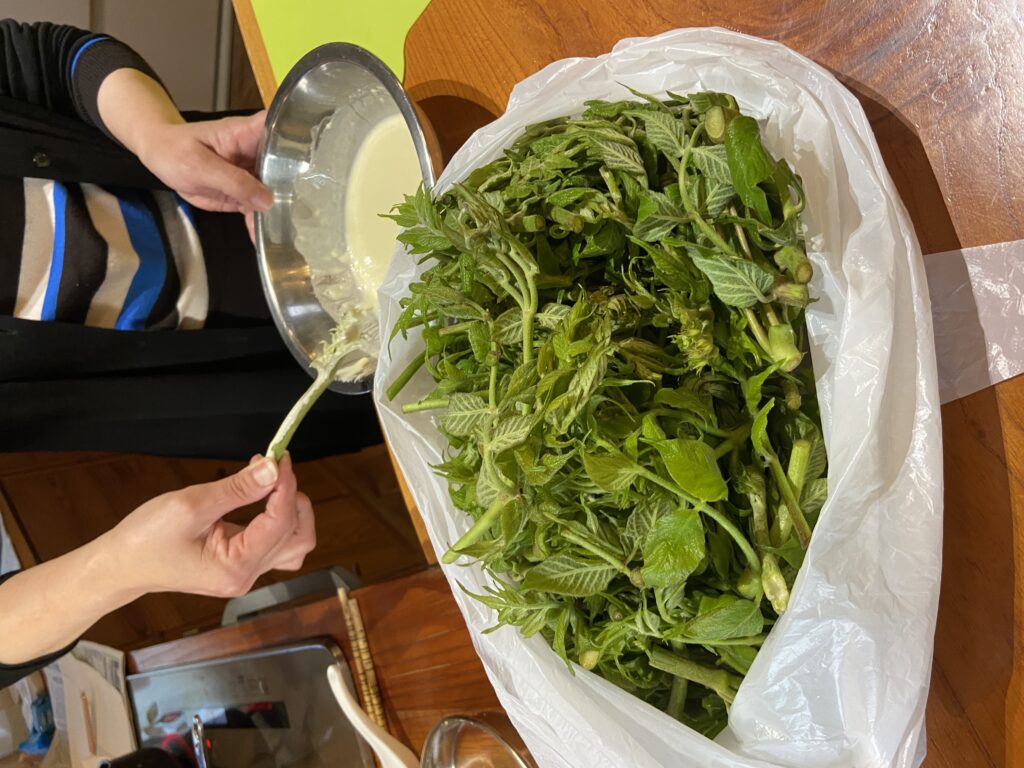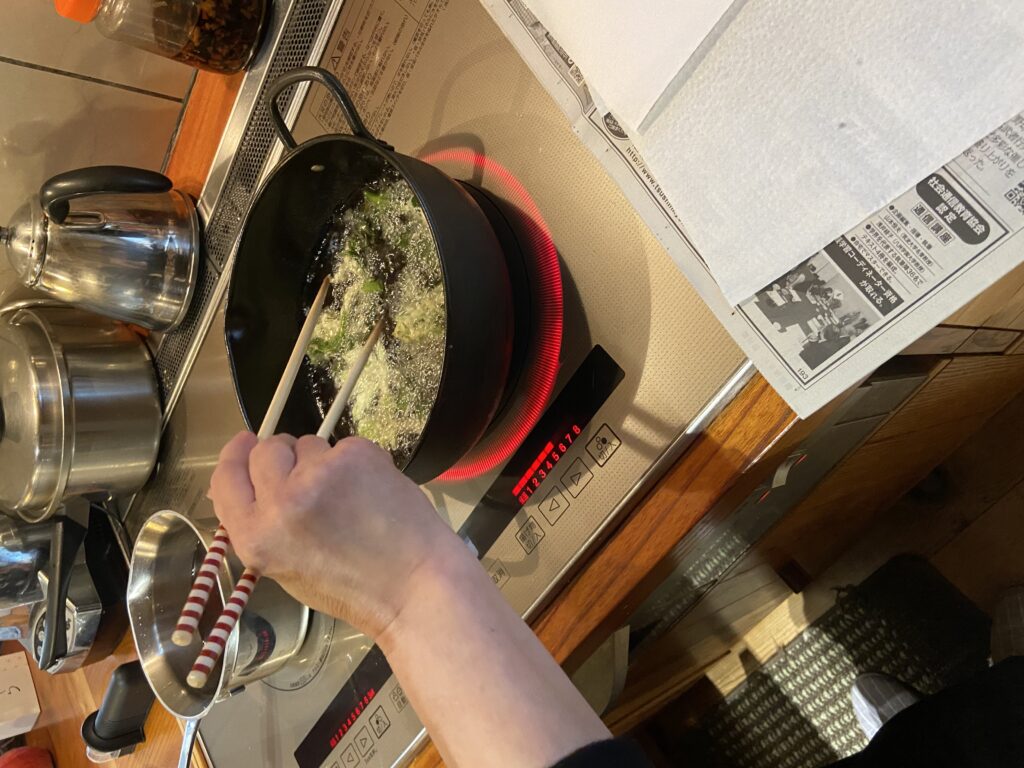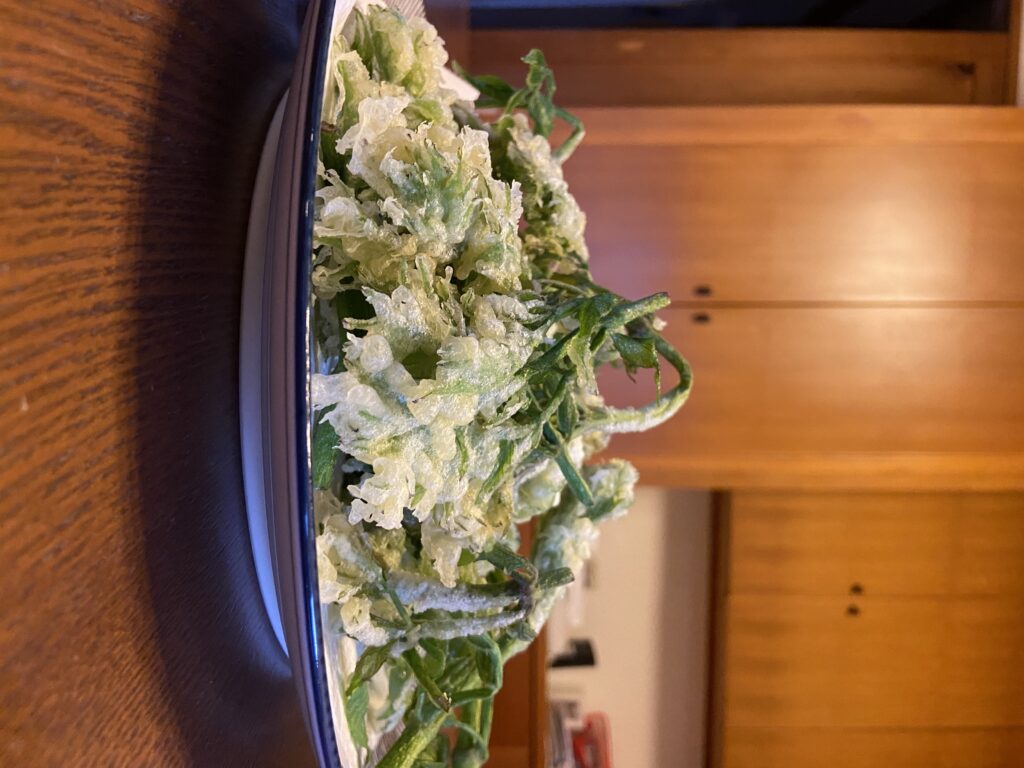Foraging and eating the iconic Japanese mountain sprout
This article originally appeared in the May 2023 issue of CONNECT.
Monica Hand (Ehime)
Bumping along in four-wheel drive, we climbed higher and higher up a steep mountain road in rural Ehime. The early morning air was damp, crisp, and earthy and the forest around us was bursting with green. The conditions were perfect, and once parked and armed with hooked canes, gloves, and foraging bags, we set out on the hunt. Ignoring the many mushrooms, we scanned the tops of slim trees, searching for a pop of green and the promise of delicious taranome.
The Foraging
Taranome is a popular sansai, or mountain vegetable, that grows throughout the country but only appears in the spring season. It is a sprout that grows from the wood of a young Japanese angelica tree (binomial name Aralia elata), its green stem shooting off from the tree’s woody base as new segments and branch growth. Though a small sprout, the taranome is beloved as much for its taste as for its nutritional value; boasting nutrients like potassium, calcium, and iron.

Like with other spring-specific sansai (e.g. bamboo shoots and warabi shoots), harvesting the wild sprout is typically a pastime of older generations in Japan’s rural regions. Knowing where to go, and getting there first, is all part of the challenge. This seems particularly crucial for the taranome because of its popularity and the fact that each tree only produces one or two sprouts. And of course, as with any foraging, it is recommended to go with a guide or someone who knows their plants. Especially as the taranome can easily be confused with a very similar looking, but quite poisonous, yamaurushi.

Luckily, our guide, a teacher at a local high school, knew just where to go and how to avoid any mix-ups. He taught us that the best way to tell the difference is that the safe sprout is guarded by the angelica tree’s prickly, woody thorns (hence the need for gloves). Meanwhile, the poisonous yamaurushi offers sprouts from smooth, inviting bark. As always, nature loves irony.

With all that in mind, we wandered and stumbled through the forest, calling out to each other through the thicket. Then, once a taranome was spotted poking out in the tree line ahead, and inspected to ensure it was not its poisonous cousin, we went to work harvesting. We used the canes (just a long branch with a hooked end) to latch onto and gently bend the thin tree. This brought the top of the tree, where the new sprouts grew, down to where another one of us stood waiting. Once it was to a reachable level, just a simple twist was enough to pluck the green gold.
Though the process was simple enough, we couldn’t harvest every taranome we found. Some of the trees were too tall or thick to safely bend down without harming the tree. Others were positioned on such a steep incline that it was impossible to get the right angle. We left these behind in hopes some future forager would be clever enough to find a way to harvest them.
But, in the end, we still ended up with two large bags full of taranome sprouts, ready to be eaten.
The Eating
While the lengths of the taranome we plucked varied, the ideal length is between three and six centimeters. The longer they are, the less ideal the texture as the growing plant becomes thicker and stronger. The ideal taranome has a tender base and a cluster of leaflets.
In South Korea, the same plant is cooked in various ways—pickled, blanched, sauteed, etc. But in Japan, the taranome sprout is mostly seen as a specialty tempura dish. Since the taste is subtle and earthy, it pairs perfectly with tempura’s light batter and a sprinkle of salt or dipped in tentsuyu, the tempura dipping sauce.



Whether bought or foraged, you can prepare your sprout for tempura by washing thoroughly, peeling away the larger leaves, and chopping off the hard bottoms. The small, feathery leaflets are the best part, as they add an extra crunch to the already crisp tempura-fried texture. For a lighter taste, dip only the leafy end of the sprouts in the tempura batter before dropping into the pan of oil.
We feasted on the tempura alongside other seasonal and traditional dishes, but the plate of taranome was first to be devoured. The delicate taste and satisfying crunch was addictive, and my chopsticks couldn’t help but to go back for more. Then, dipping the sprout in the mixture of tentsuyu and grated radish was a delightful mix of flavor and textures I hadn’t realized I was missing.

Even after just one meal, it was easy to see why it’s often called the king of sansai. A limited season makes it a fleeting treasure, a taste so subtle and earthy that it fits perfectly with Japanese traditional cooking, and a smell so fresh that when cooking, the whole kitchen smells of spring. Taranome is truly a spring icon.
Monica is a second-year ALT based on the rural and lush Shikoku island. She loves rocky shore lines, salty popcorn, and a juicy plot twist.




